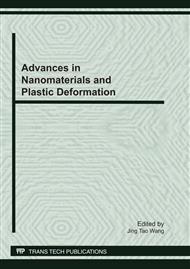p.115
p.123
p.131
p.139
p.145
p.153
p.159
p.167
p.171
Effect of Load Direction on Tensile Yield Properties in Mg-3Al-Zn Alloy
Abstract:
Deformation anisotropy of samples from rolled sheet and extruded rod of AZ31 alloy was investigated in the present work. A strong basal plane texture is detected formed during rolling and extrusion, and both rolled and extruded samples exhibit similar mechanical behavior: tensile yield strength is the highest in the specimens parallel to the longitudinal direction, and decrease continuously as the specimen orientation departs from the longitudinal direction. Using texture analysis and optical microscopy it has been found that, the obvious anisotropy can be explained by texture and orientation factor during tension and compression. Basal slip and twinning are restricted when tensile load is applied in the rolling and extrusion direction, which results in high tensile yield strength along the two directions.
Info:
Periodical:
Pages:
145-151
Citation:
Online since:
March 2011
Authors:
Keywords:
Price:
Сopyright:
© 2011 Trans Tech Publications Ltd. All Rights Reserved
Share:
Citation:


